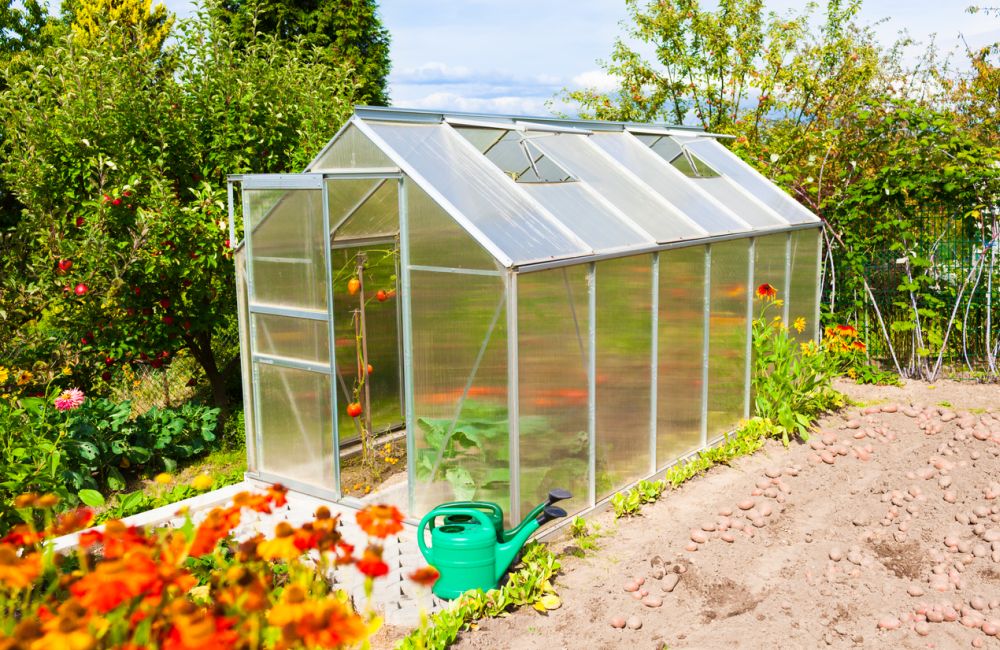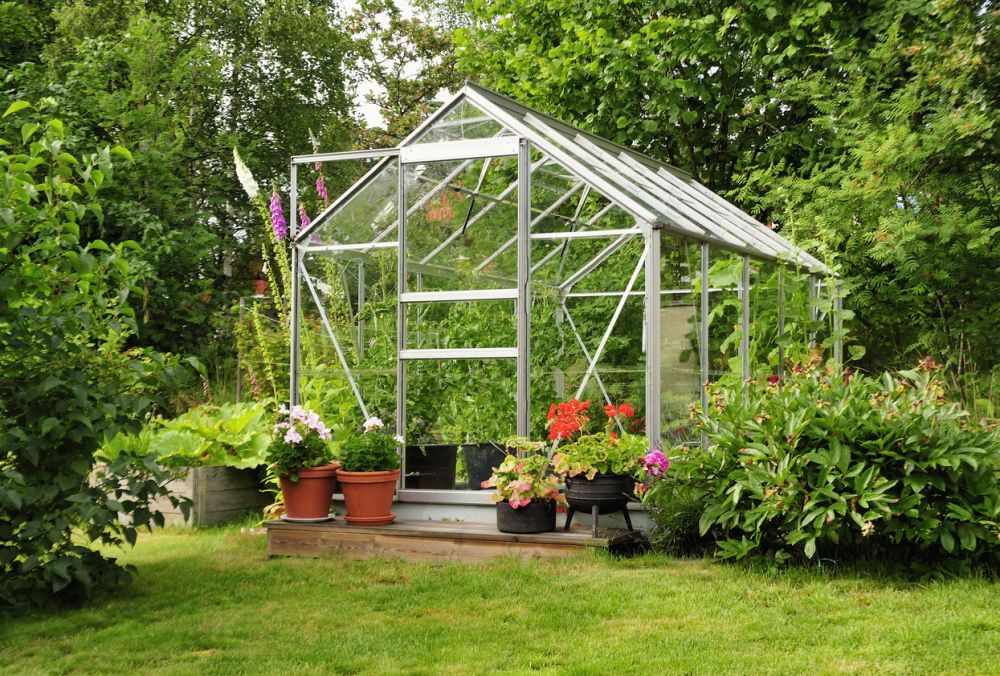Greenhouse Location Selection – Greenhouse Site and Other Considerations
A greenhouse location is more than just a convenience. It can make or break the whole all-year-long-planting experience. You want to have a greenhouse because the growing season is too short, or you don’t have the right weather conditions for many of the plants you want to grow. But there are some factors to consider and problems to sidestep when setting up your greenhouse.
Some of those problems have to do with selecting the wrong greenhouse type or size for the space available in your garden. Others are more related to the ventilation, heat, and even the very plants you choose to grow in the greenhouse. But above all, it’s about the greenhouse location. We put together this guide to help you get started with your greenhouse project. It helps you pick the right greenhouse site, troubleshoot common issues, and offers some expert tips, so you get the most out of your greenhouse.
Greenhouse Types
Before we can talk about the best location for your greenhouse, we need to know what greenhouse types are there. Depending on your experience and skill levels, you would want to select a greenhouse that can be built without using power tools or the need for a professional’s help. Here are the two main greenhouse types.
- Stand-alone: A freestanding greenhouse is easy to set up anywhere you like. It doesn’t need a wall to lean on or a house or shed to give it support. This is the more convenient of the two types since it is easier to build and can be ready to use on the same day. The initial cost of this type is rather steep. But when you consider that you can grow a lot more plants in it, they tend to save you money down the line.
- Lean-to: You’ll need to have a sturdy wall next to the greenhouse location to provide support for the lean-to greenhouse. That wall means you will have less construction to do since you only have to install 3 walls instead of 4. This type is good for you if you’re on a budget. However, there are limitations regarding space inside and the amount of light that you get. That one wall providing support usually means at least one side of the greenhouse will not be getting light.
A stand-alone greenhouse is a better option if you can afford it. It allows you to grow a lot of different plants inside, including large perennials. The lean-to greenhouse is more suitable for herbs, seedlings, and small patches of veggies.
Greenhouse Location Selection
So what about the greenhouse location that makes it such a deal-breaker? Well, for one thing, the greenhouse site dictates how much sunlight it gets on average. It also controls the amount and quality of ventilation the plants inside get. Since freestanding greenhouses give you more options in terms of location, among other advantages, we will be talking about them here. Here are some factors that help you select the best greenhouse location.
- Proximity to Garden: You should select a site for your greenhouse that is as close to the garden or house as possible. That makes it easy for you to spend more time in the greenhouse. If you set up your greenhouse on a remote corner of the property, chances are you’ll probably forget it’s even there.
- Access to Utilities: Your greenhouse will need access to running water and electricity outlets. So make sure you pick a spot that has access to both of these utilities. A permanent electricity outlet and a running water tap right next to the greenhouse make it easier and more convenient to maintain the greenhouse than using extensions or long garden hoses.
- South or West Orientation: Make sure the greenhouse is standing on a spot in your garden that faces either the south or west. Those two directions get the maximum sunlight hours per day. You should aim for at least 6 hours of sunlight every day as most plants need that much sun to grow. If you don’t get so many hours of the sun, especially in the winter, you can use grow lights.
- Neighboring Trees: You should also consider what type of tree is casting its shadow on your greenhouse. If it’s a deciduous tree, then it’s the ideal neighbor. It offers much-needed shade in the summer, and when it sheds its leaves in the winter, it allows the light in. A conifer, on the other hand, will make it much darker inside the greenhouse in the fall and winter.
- Drainage: The surface you place the greenhouse on should be level, but it also needs to provide good drainage. Many of the plants you grow inside will be in pots which means the excess water will go straight to the ground. This could create a problem with weeds and invasive plants, and waterlogged soil. So spread a sheet and cover it with about three inches of gravel before you install your greenhouse. This offers good drainage to the plants and prevents the spread of weeds.
Troubleshooting Common Greenhouse Location Problems
You chose the right greenhouse location and got your greenhouse all set up, but that doesn’t mean that you can start planting right away. There are other considerations to factor in and get out of the way before your greenhouse is ready to grow its first plant. Here are some of those problems and how to fix them.
Mold
Mold will start growing all over the sides of the greenhouse and even the plants themselves if you have too much humidity in the air. The problem is some plants need more humidity than others. So growing some plants that require misting on a daily basis along with other plants that prefer drier conditions is an open invitation for mold.
You should group plants by their humidity preferences and grow them altogether. That way, you can regulate the humidity levels in the greenhouse and avoid the problem of mold and other infestations. Mold also is a direct result of poor ventilation.
Poor Ventilation
Your greenhouse always comes with air vents. These vents help improve the air circulation inside the greenhouse and regulate the temperature and humidity inside. If you set up the greenhouse in the wrong location or these vents get blocked, the air inside becomes too hot and humid for the best interests of the plants. Even the hardiest of plants wouldn’t survive such extreme conditions. You should inspect the air vents regularly and make sure the air circulation is at optimal levels.
Wrong Soil
Unlike plants grown in the garden or in pots, the plants inside the greenhouse require a special type of soil. Regular soil is just too heavy and too poorly drained for use in the greenhouse. That type of soil makes the pots too heavy to carry around. It gets dry quickly at the top of the pot while the bottom remains wet.
Instead, you should use a soilless potting mix for all the plants in the greenhouse. Good candidates of this type include coir and peat moss. They are lightweight and maintain the same level of moisture both at the top and bottom of the pot.
Too Much or too Little Shade
As much as sunlight is important for the health of your greenhouse plants, shade is also crucial for their success. The need for shade is at its height at the peak of summer. The sun bearing down on the greenhouse increases the temperature to a level beyond any plant’s tolerance. So you need a good deciduous tree to cast its shade on the greenhouse in the afternoon.
But too much shade is just as bad as too little shade. If a building is keeping the light from the greenhouse in the winter, then the plants will have a little chance of surviving.
Heating
Heating can become a real problem if you have prolonged winter months where the temperature drops sharply at night. That’s the main reason for using a greenhouse in the first place. To be able to regulate the temperature around the plants and keep them growing successfully regardless of the weather conditions outside.
Greenhouse heaters can handle high levels of humidity and moisture. That rules out using any regular heater that you find lying around the house. So invest in a good heater to provide stable temperatures for the plants all year round. Another accessory that comes in handy with the greenhouse heater is a surge protector. It will safeguard the heater and the plants against power surges, such as when a storm hits.
Pests
As with any other place that houses plants, your greenhouse might be a breeding ground for all sorts of pests. The stable temperature, high levels of humidity, and protection from the harsh elements outside are all factors that work in favor of pest infestations. The best way to prevent this pest problem is to check the plants for any signs of pests before you allow them inside the greenhouse. The same rule applies to gardening tools such as hoes, spades, and rakes. Always clean your tools after using them to prevent such pest infestations inside the greenhouse.
Tips for Selecting Greenhouse Location
Here are a few tips from the experts to keep your greenhouse in top shape no matter what weather conditions you face or the type of plants you grow inside.
- Always level the ground before you install the greenhouse. This ensures the structure is sturdy and stable even in the face of strong winds.
- Try to keep your greenhouse as far away as possible from farms and other agricultural areas. This will minimize the risk of pest infestations and other problematic wildlife such as rodents, gophers, and rabbits.
- Don’t build your greenhouse in the shadow of a building or any other permanent construction. Come winter, the lack of natural light could kill the plants.
- Use a temperature alarm to alert you of the drop in temperatures inside the greenhouse in the winter. That way, you’ll know when to turn on the heater for the plants.


